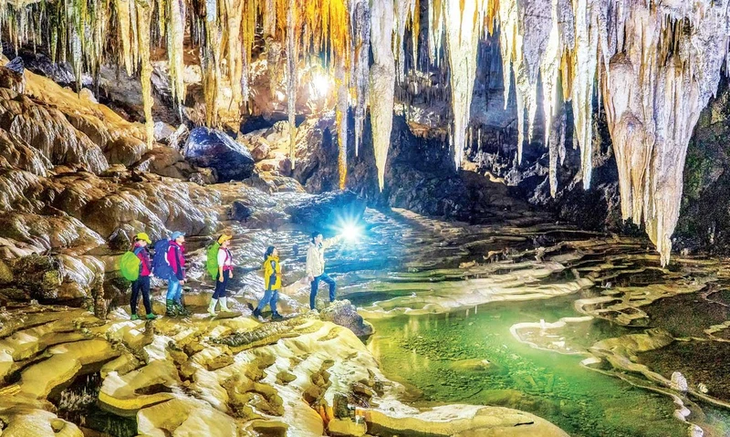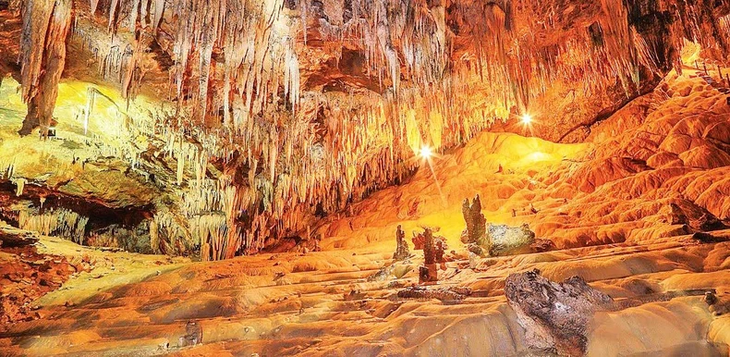Pu Sam Cap, a group of 10 caves, is dubbed the “top caves of the Northwest” for its pristine, mysterious beauty which is especially attractive to adventurers.

Inside the Heaven cave of Pu Sam Cap complex in Lai Chau province. (Photo: Xuan Loc)
The magnificent cave complex located deep in the mountain range in Lai Chau province was discovered by local people when they cleared the land for cultivation in July of 2006.
Sitting at a height of 1,300 to 1,700 meters above sea level, it is considered by local people as a wonderful treasure, a perfect product of nature. Many people say Pu Sam Cap is as beautiful as Phong Nha - Ke Bang cave in Quang Binh Province, Thien Duong Cave in Quang Ninh Province, and Huong Tich Cave in Hanoi.
Le Van Tranh, an officer with the Department of Culture, Sports, and Tourism of Lai Chau Province, said: “The group of Pu Sam Cap caves is about 6 kilometers from Lai Chau City. In the indigenous Thai language, Pu Sam Cap means three mountains, which have three major caves within them called, Heaven (Thiên Đường), Heaven’s Gate (Thiên Môn) and Glass (Thủy Tinh). Lai Chau Province has opened tours to the Heaven and Heaven’s Gate Caves.”
After climbing the stone steps of a few hundred meters from the foot of the mountain, travelers arrive at the entrance to the Heaven’s Gate Cave. Looking down inside the cave, tourists will be thrilled at the wildness and mystery of a bottomless cave. When standing in the cave, tourists find themselves lost in a strange world of vivid artistic works created by nature. Stalactites hanging from the ceiling and stalagmites rising from the ground extend endlessly appearing as a miniature landscape of the Northwest mountains and forests.
Depending on each individual’s imagination, the stalactites and stalagmites assume different shapes.
The center of the cave is a high, wide dome, creating a space of about 6,000 square meters. The cave’s floor is relatively flat and interspersed with large and small pools. At the end of the cave, the scene is as magnificent and splendid as a palace with iridescent stalactite columns where some people like to reflect.
“The Heaven’s Gate Cave has a very old geological structure interlacing with new geological formations that are still changing. The cave is huge and can accommodate thousands of people. Its ceiling is as high as 50 to 60 meters. There are many stalactites with strange shapes,” said Tranh.

The magical beauty of the Pu Sam Cap cave system. Photo: Lai Chau information portal
Leaving the Heaven’s Gate Cave, people walk to the Heaven Cave, which is like a fairyland - quiet and mysterious. Near the entrance, there is a stalactite shaped like a sitting-lion. Standing on the cave’s floor and looking up, tourists will be overwhelmed by the giant dome.
Stalactites hang down like a flower trellis with magical shapes. There is a huge stalagmite which looks like a tall glass column with delicate images carved by skilled artisans. In the cave’s center, the Creator has made a clear lake with a prominent stalagmite which researchers estimate has been building for millions of years.
On the cliff, there are stalactites arranged in layers like terraced fields in the ripening rice season. Below them are smaller stalagmites which resemble people working on the fields.
Do Duc Thanh, a resident in Lai Chau City, said: “Each cave has its own beauty. Besides their cultural value, the history of the caves is also a testament to the activities and existence of ancient indigenous people. Pu Sam Cap complex is like a shield of the Hoang Lien Son Range to protect Lai Chau City.”
The Glass Cave is the third huge cave in Lai Chau. But it has not been fully discovered and opened to tourists because the path to the cave is quite dangerous. But visitors can now freely venture into the Heaven’s Gate and Heaven Caves and other smaller ones within the Pu Sam Cap complex.